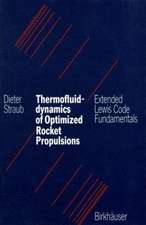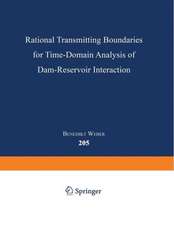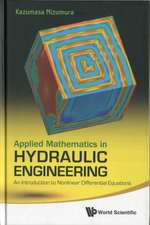Optimization in Elliptic Problems with Applications to Mechanics of Deformable Bodies and Fluid Mechanics: Operator Theory: Advances and Applications, cartea 119
Autor William G. Litvinoven Limba Engleză Hardback – apr 2000
| Toate formatele și edițiile | Preț | Express |
|---|---|---|
| Paperback (1) | 956.33 lei 6-8 săpt. | |
| Birkhäuser Basel – 31 oct 2012 | 956.33 lei 6-8 săpt. | |
| Hardback (1) | 962.66 lei 6-8 săpt. | |
| Birkhäuser Basel – apr 2000 | 962.66 lei 6-8 săpt. |
Din seria Operator Theory: Advances and Applications
- 18%
 Preț: 890.54 lei
Preț: 890.54 lei - 20%
 Preț: 574.08 lei
Preț: 574.08 lei - 18%
 Preț: 1127.60 lei
Preț: 1127.60 lei - 15%
 Preț: 643.34 lei
Preț: 643.34 lei - 18%
 Preț: 961.55 lei
Preț: 961.55 lei -
 Preț: 395.63 lei
Preț: 395.63 lei - 15%
 Preț: 648.05 lei
Preț: 648.05 lei - 18%
 Preț: 737.71 lei
Preț: 737.71 lei - 15%
 Preț: 653.14 lei
Preț: 653.14 lei -
 Preț: 384.48 lei
Preț: 384.48 lei - 15%
 Preț: 644.82 lei
Preț: 644.82 lei - 15%
 Preț: 645.79 lei
Preț: 645.79 lei -
 Preț: 402.00 lei
Preț: 402.00 lei - 15%
 Preț: 650.04 lei
Preț: 650.04 lei - 15%
 Preț: 660.83 lei
Preț: 660.83 lei - 15%
 Preț: 639.08 lei
Preț: 639.08 lei - 18%
 Preț: 940.09 lei
Preț: 940.09 lei - 15%
 Preț: 648.05 lei
Preț: 648.05 lei -
 Preț: 388.90 lei
Preț: 388.90 lei - 18%
 Preț: 728.11 lei
Preț: 728.11 lei - 20%
 Preț: 574.08 lei
Preț: 574.08 lei - 15%
 Preț: 645.79 lei
Preț: 645.79 lei - 18%
 Preț: 1128.89 lei
Preț: 1128.89 lei - 15%
 Preț: 646.11 lei
Preț: 646.11 lei - 15%
 Preț: 648.89 lei
Preț: 648.89 lei - 18%
 Preț: 745.33 lei
Preț: 745.33 lei - 18%
 Preț: 1124.47 lei
Preț: 1124.47 lei - 15%
 Preț: 647.08 lei
Preț: 647.08 lei - 15%
 Preț: 662.62 lei
Preț: 662.62 lei -
 Preț: 392.75 lei
Preț: 392.75 lei - 18%
 Preț: 960.96 lei
Preț: 960.96 lei - 15%
 Preț: 646.43 lei
Preț: 646.43 lei - 18%
 Preț: 738.37 lei
Preț: 738.37 lei
Preț: 962.66 lei
Preț vechi: 1173.97 lei
-18% Nou
Puncte Express: 1444
Preț estimativ în valută:
184.23€ • 200.04$ • 154.75£
184.23€ • 200.04$ • 154.75£
Carte tipărită la comandă
Livrare economică 22 aprilie-06 mai
Preluare comenzi: 021 569.72.76
Specificații
ISBN-13: 9783764361990
ISBN-10: 3764361999
Pagini: 548
Ilustrații: XXII, 522 p.
Dimensiuni: 155 x 235 x 35 mm
Greutate: 0.94 kg
Ediția:2000
Editura: Birkhäuser Basel
Colecția Birkhäuser
Seria Operator Theory: Advances and Applications
Locul publicării:Basel, Switzerland
ISBN-10: 3764361999
Pagini: 548
Ilustrații: XXII, 522 p.
Dimensiuni: 155 x 235 x 35 mm
Greutate: 0.94 kg
Ediția:2000
Editura: Birkhäuser Basel
Colecția Birkhäuser
Seria Operator Theory: Advances and Applications
Locul publicării:Basel, Switzerland
Public țintă
ResearchCuprins
1 Basic Definitions and Auxiliary Statements.- 1.1 Sets, functions, real numbers.- 1.2 Topological, metric, and normed spaces.- 1.3 Continuous functions and compact spaces.- 1.4 Maximum function and its properties.- 1.5 Hilbert space.- 1.6 Functional spaces that are used in the investigation of boundary value and optimal control problems.- 1.7 Inequalities of coerciveness.- 1.8 Theorem on the continuity of solutions of functional equations.- 1.9 Differentiation in Banach spaces and the implicit function theorem.- 1.10 Differentiation of the norm in the space Wpm(?).- 1.11 Differentiation of eigenvalues.- 1.12 The Lagrange principle in smooth extremum problems.- 1.13 G-convergence and G-closedness of linear operators.- 1.14 Diffeomorphisms and invariance of Sobolev spaces with respect to diffeomorphisms.- 2 Optimal Control by Coefficients in Elliptic Systems.- 2.1 Direct problem.- 2.2 Optimal control problem.- 2.3 The finite-dimensional problem.- 2.4 The finite-dimensional problem (another approach).- 2.5 Spectral problem.- 2.6 Optimization of the spectrum.- 2.7 Control under restrictions on the spectrum.- 2.8 The basic optimal control problem.- 2.9 The combined problem.- 2.10 Optimal control problem for the case when the state of the system is characterized by a set of functions.- 2.11 The general control problem.- 2.12 Optimization by the shape of domain and by operators.- 2.13 Optimization problems with smooth solutions of state equations.- 3 Control by the Right-hand Sides in Elliptic Problems.- 3.1 On the minimum of nonlinear functionals.- 3.2 Approximate solution of the minimization problem.- 3.3 Control by the right-hand side in elliptic problems provided the goal functional is quadratic.- 3.4 Minimax control problems.- 3.5 Control of systems whose state is described by variational inequalities.- 4 Direct Problems for Plates and Shells.- 4.1 Bending and free oscillations of thin plates.- 4.2 Problem of stability of a thin plate.- 4.3 Model of the three-layeredplate ignoring shears in the middle layer.- 4.4 Model of the three-layered plate accounting for shears in the middle layer.- 4.5 Basic relations of the shell theory.- 4.6 Shells of revolution.- 4.7 Shallow shells.- 4.8 Problems of statics of shells.- 4.9 Free oscillations of a shell.- 4.10 Problem of shell stability.- 4.11 Finite shear model of a shell.- 4.12 Laminated shells.- 5 Optimization of Deformable Solids.- 5.1 Settings of optimization problems for plates and shells.- 5.2 Approximate solution of direct and optimization problems for plates and shells.- 5.3 Optimization problems for plates (control by the function of the thickness).- 5.4 Optimization problems for shells (control by functions of midsurface and thickness).- 5.5 Control by the shape of a hole and by the function of thickness for a shallow shell.- 5.6 Control by the load for plates and shells.- 5.7 Optimization of structures of composite materials.- 5.8 Optimization of laminate composite covers according to mechanical and radio engineering characteristics.- 5.9 Shape optimization of a two-dimensional elastic body.- 5.10 Optimization of the internal boundary of a two-dimensional elastic body.- 5.11 Optimization problems on manifolds and shape optimization of elastic solids.- 5.12 Optimization of the residual stresses in an elastoplastic body.- 6 Optimization Problems for Steady Flows of Viscous and Nonlinear Viscous Fluids.- 6.1 Problem of steady flow of a nonlinear viscous fluid.- 6.2 Theorem on continuity.- 6.3 Continuity with respect to the shape of the domain.- 6.4 Control of fluid flows by perforated walls and computation of the function of filtration.- 6.5 The flow in a canal with a perforated wall placed inside.- 6.6 Optimization by the functions of surface forces and filtration.- 6.7 Problems of the optimal shape of a canal.- 6.8 A problem of the optimal shape of a hydrofoil.- 6.9 Direct and optimization problems with consideration for the inertia forces.
Recenzii
“The monograph is written in an accessible and self-contained manner. It would be of a great interest to researchers working in optimization theory for partial differential equations and its applications as well as for graduate students with interests in applications of the theory of optimal control to real problems from mechanics.” (U.Raitums, zbMATH 0947.49001, 2022)














